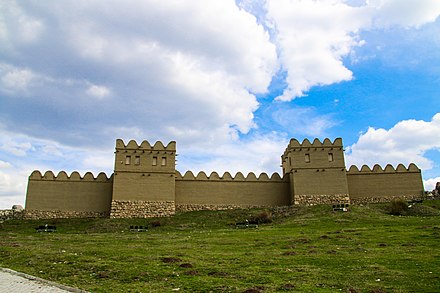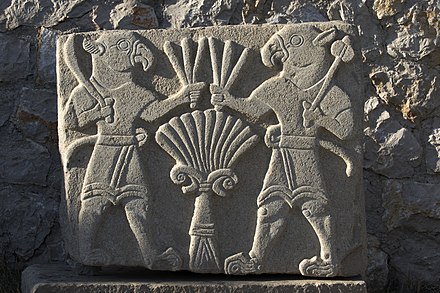Hittites
Hittites
The Hittites were a Bronze Age Anatolia people who established an empire with Hattusa as its capital from 1600 BCE to around 1180 BCE, reaching its apex during the mid-14th century BCE. It collapsed at about the same time as several other civilizations in the "Late Bronze Age Collapse" for reasons historians still debate.
Neo-Hittite states who based their political legitimacy on supposed descent from the Hittite Empire existed in the Levant for centuries afterwards. It was those "Hittites" that are described in the Bible as they came into contact with the Israelites and the name "Hittite", used in modern parlance when referring to them, stems from those post-Hittite polities.
Understand
The earliest Anatolians known to form an organized state, the Hittites seemingly appeared out of thin air in the high plateau of northern Central Anatolia, although they identified much with their predecessors, the Hattis, who were of equally obscure origins.
 At their peak, the Hittites were a great power, with their area of control stretching well into modern-day Syria and Lebanon. The Hittites were comparable in might to their Ancient Egypt and Assyrian neighbors, with whom they were often in an uneasy relationship. An attempted Egyptian invasion in 1274 BC was stopped by the Hittites at the city of Kadesh, on the Orontes River in what is now Syria. In the aftermath, the opposing sides celebrated the Egyptian–Hittite peace treaty, the first of its kind in recorded history, and the only ancient Near Eastern treaty for which both sides' versions have survived. The original tablets are in Istanbul's Archaeological Museum, while a replica is displayed in the United Nation headquarters in New York. It was ratified in the 21st year of pharaoh Ramses II's reign (1258 BCE) and continued in force until the Hittite Empire collapsed, 80 years later.
At their peak, the Hittites were a great power, with their area of control stretching well into modern-day Syria and Lebanon. The Hittites were comparable in might to their Ancient Egypt and Assyrian neighbors, with whom they were often in an uneasy relationship. An attempted Egyptian invasion in 1274 BC was stopped by the Hittites at the city of Kadesh, on the Orontes River in what is now Syria. In the aftermath, the opposing sides celebrated the Egyptian–Hittite peace treaty, the first of its kind in recorded history, and the only ancient Near Eastern treaty for which both sides' versions have survived. The original tablets are in Istanbul's Archaeological Museum, while a replica is displayed in the United Nation headquarters in New York. It was ratified in the 21st year of pharaoh Ramses II's reign (1258 BCE) and continued in force until the Hittite Empire collapsed, 80 years later.
The Luwians were an associated, linguistically-related people mainly living in the west, south-central, and south of Anatolia. During both the empire and Neo-Hittite periods, they were so intertwined with the Hittites that the Assyrians called all Anatolians, without distinction, nuwaʿum after them.
Destinations
Historic sites are in green while museums housing Hittite artifacts are in blue.
In Turkey
The most important Hittite sites of Anatolia can be geographically grouped into four areas: the ancient Hittite heartland in what is now Çorum Province in Northern Anatolia, the southern reaches of Central Anatolia on the foothills of the Taurus Mountains, Southern Turkey east of Adana, and the eastern outposts of the empire around Malatya. There is also a scattering of associated sites in Western Anatolia.
Northern Anatolia
A couple hundred kilometres northeast of Ankara, this is where the Hittites first established their kingdom and the countryside is littered with a large number of sites.
-
Çorum Museum, 40.5419°, 34.9510°. The museum of the region's modern capital hosts some artefacts excavated from the surrounding countryside. 2017-01-27
-
Boğazkale, 40.0216°, 34.6088°. South of Çorum, Boğazkale is a modern village just next to the ruins of the Hittite capital of Hattuşa 📍, making it one of the few Hittite sites relatively easy to access by public transport. While the ruins themselves are little more than foundation stones, it is easy to visualize how large a city this must have been in its heyday, and partially reconstructed city walls certainly help with this. Farther from the village, although still within walking distance if you are in reasonable shape, is the sanctuary of Yazılıkaya 📍, an impressive set of rock reliefs depicting the numerous Hittite gods. Both sites together constitute a UNESCO World Heritage site. 2020-09-12
-
Alacahöyük. Much of the rich Hittite collection of Ankara's Museum of Anatolian Civilizations was excavated here. The Hittite name of the place is yet to be identified, although the extensive ruins indicate that it was already a substantial community before the Hittite take-over. In the outskirts, the Gölpınar Dam dates back to 1240 BCE, built after a drought hit the Anatolian highlands, so that the Hittites would never put themselves to shame again by having to import wheat from their rivals, the Egyptians, to avoid famine. 2020-09-28

- Museum of Anatolian Civilizations, 39.938333°, 32.861944°. For travellers with even the slightest interest in the Anatolian history, no trip to Turkey is complete without a visit to this museum in the capital city, as it displays much of the crème de la crème of ancient Anatolian (as well as ancient Near Eastern) art. The Hittites are the venue's major stars, with their artifacts aiways given the most honourable, prominent positions in the museum—an exact replica of a huge Hittite statue excavated from Fasıllar near Konya welcomes visitors in the front yard. Indeed, during the nation-building process of the early years of the modern republic, Ankara strongly identified itself with its Hittite origins, celebrated by the modern Hittite Sun Course Monument placed in the middle of Sıhhiye Square's roundabout. 2020-09-07
Along the Taurus Mountains
The southern extension of Central Anatolia is home to a number of striking and solitary sites literally lost in the hilly landscape.
- Eflatunpınar, 37.8256°, 31.6739°. A monument with numerous reliefs surrounding it, on the side of a pool formed by a local spring held sacred by the Hittites. Probably intended as a base of a large statue that was never to be placed, the medieval Seljuk Turks presumed it was a memorial to ancient Greek philosopher Plato, and hence the name "Plato's spring". 2017-01-27
- İvriz, 37.4092°, 34.1727°. A large (4.2 m high and 2.4 m wide) rock relief at the end of a canyon, dating back to the 8th century BC and depicting Warpalawas, the king of the time and Tarhunzas, the storm god together, the god bestowing cereal ears and bunches of grapes to the king. 2017-01-27
- Kültepe. This is the site of ancient Kanesh or Nesha. The Hittite endonym for themselves and their language, nešili, suggests an origin here, before they took over the Hattian capital Hattuşa and adopted their geographical and political names. Here, the Assyrians maintained their largest karum — functioning much like the present-day free trade areas, these were multiethnic hubs of the Assyrian trade routes, which exported Anatolian tin and wool and brought over woven fabrics, foodstuff, and spices from Mesopotamia and Elam (Western Iran). 2020-09-07
Southern Turkey
After the old kingdom centred around Hattuşa fell in the 12th century BC as part of the Late Bronze Age collapse that took place around the larger Eastern Mediterranean (due to numerous reasons, including loss of traditional trade partners, invasions from unfriendly neighbours, spread of ironworking technology and its advantages in weapon production over bronze and some even theorize environmental changes due to the eruption of some far away volcano), a number of successor states, collectively known as "Neo-Hittite" or "Syro-Hittite", emerged in what is now southern Turkey and northern Syria. Some major Neo-Hittite sites dot the countryside east of Adana.
- Karatepe-Aslantaş National Park, 37.2959°, 36.2531°. An open air museum inside the dense pine forest almost fully encircled by a dam lake (hence the local name Hitit Yarımadası, "the Hittite Peninsula") was the site of an ancient Neo-Hittite settlement, the walls of which still remain and surround the site. The museum exhibits a series of stone reliefs in a style with an unmissable Near Eastern influence, as well as a number of large-ish free standing statues, including that of the Phoenician thunder god Baal, absorbed into the Hittite pantheon as Tarhunzas. 2017-01-27
- Yesemek, 36.9051°, 36.7436°. Yesemek was a Hittite quary and statue workshop, with an entire hillside dotted by an almost uncountable number of half-finished statues that would be distributed all over the empire had they been completed before the quarry was abandoned after the collapse of the empire. 2017-01-27
Eastern Anatolia

- Darende, 38.547222°, 37.511111°. Some distance out of the town, two solitary lion statues facing eastwards are thought to be the remnants of a Hittite temple.
- Arslantepe. A far more interesting and extensive set of ruins than neighbouring Darende's 'Lion Rocks', a number of detailed sculptures with typically Hittite designs were excavated in the site and have been exhibited there.
Western Anatolia
Arzawa was a rival federation based in the valley of the Kaystros River (the modern Küçükmenderes). It became associated with or was conquered by the Hittites in the 15th century BCE. Since their territory — exceptionally fertile with a mild climate — has been home to several civilizations afterwards, not much remained from them: e.g. their capital Apasa was later completely re-built as Greco-Roman Ephesus.
- Manisa Relief. A rock relief depicting a Hittite deity. It's been long thought to be Cybele, the Anatolian fertility goddess, but this is uncertain.
- Karabel Relief. Another relief carved into the cliff face, this one depicting King Tarkasnawa of Mira, one of the vassal states formed after the Hittite conquest of Arzawa.
Rest of the Near East
- Aleppo. After being conquered in the 15th century BCE, Aleppo took on a spiritual role, known for the temple of the storm god, the remains of which are partially standing. 2020-09-09
Elsewhere
- Oriental Institute Museum.
Do
- The Hittite Trail (the official website is in Turkish only; the English webpage from the Culture Routes Society Turkey) is a collection of signposted hiking and cycling routes in the Hittite heartland, taking advantage of the ancient trails wherever possible while connecting the associated sites to each other. The cumulative length of the routes totals up to 400 km.
Talk
The Hittite language was an ancient Indo-European language and therefore related to English. Indeed, even in a single sentence like the above, it is possible to find several cognates with English and other modern Indo-European languages: nu is "now", ezza is "eat" (cf German essen), and waatar is, guess what, "water". Ekuu is "drink"; the meaning of its cognates shifted to "water" in some of the related languages like Latin, aqua. These four words (and of course earlier knowledge of cuneiform the Hittites adapted from Mesopotamia) greatly helped Czech linguist Bedřich Hrozný in correctly identifying the language as Indo-European, and faciliated the eventual decipherment of the ancient language.
Hittite is the oldest attested language in the family but unlike Latin, Greek or Sanskrit, it has no modern-day descendants. Indeed the Anatolian branch of Indo-European has been extinct for 1,500 years.